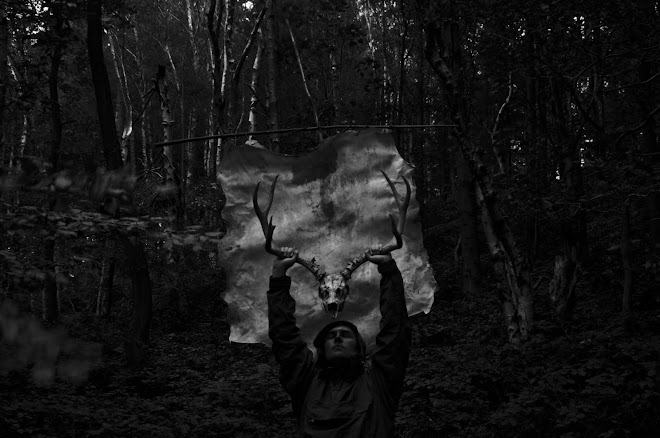
This account of the ascent of Roseberry Topping was first published on the THB MySpace page in January 2007.
On the last day of 2006 I climbed Roseberry Topping, a numinous conical hill first recorded in 1119 as Othenesberg and sacred to Odin. Wuotan, Wodhanaz, Óðinn, Oden, Wodan, Woden, Odin. Over 235 names and titles are known for the. ruler of the Æsir. The All-Father is All-Things to All-People. A God of runes, magic's and wars. A God of the hanged and the Wild Hunt. A God of storms, rains and harvests. A shape-shifter, a giver of the gifts of madness, of poetry and creativity. Subtle, wily, mysterious and dangerous.
Accordingly 31st December 2006 in northern England was an unpredictable day of storms. Driving through the low fields on the south side of the river Tees the car was rocked by the buffeting winds and blinded by the spray from flooded ditches. Roseberry Topping stands out in grim isolation, a huge age-worn crag jutting out from the northern wall of the moors. The Old Norse name for the hill was Odins-Beorg, this changed gradually, the march of the English language eroding the sharp heathen corners from thought and memory, slowly renaming and redefining Othensberg, Ohenseberg, Ounsberry, Ouesberry and now Roseberry.
Walking up the track that leads to the foot of the hill one had to negotiate the run-off from the fields, little rivers of yellow iron rich water making their way towards the sea. The wind whistled through the bare hedges, bending the dead grass and making the holly leaves rattle together like winter's bones. The land lay dull and sleeping. Green had fled and brown was king.
Below the hill a wide wood of tall oaks, trunks rising, crowns spreading, the old years leaves gathering in deep earth coloured drifts with mast rolling under foot. The path to the top lead up through these woods. Above us the trees creaked in the storm like the rigging on a vast ship whilst here and there fallen branches and limbs lay among the leaves, things of the air cast down to earth. The path snaked around the lower shoulders of the hill, steep and rocky, wet and muddy until rising higher one became aware of a deep stillness.
I looked out over the tops of the trees and had the unearthly sensation of being above the wind. The roaring beneath contrasted sharply with the quiet of the immediate surroundings as the swaying, roaring ebb and flow of the storm passed through the bare forest below. The weird detachment did not last, as the path rounded another bend on the hillside the landscape changed to a sparse blasted moorland of grass and gorse the wind swept in again, pulling at clothing, ripping at voices and chilling flesh.
The path stretched out above, steeper and steeper until the summit of the hill broke the clouds in a sharp horn. Close to the top the winds grew stronger, making climbing harder, making each footfall doubtful. The final hundred feet to the summit were reached in a scramble over slick wet rocks and tussocked grass, sometimes the wind blew from behind and seemed to help one climb, other gusts came in violently from the side as if to rid the hill of human presence. Just below the summit a network of large rocks with small recesses and nooks offered some shelter as the screaming wraith-wind blew tatters of cloud past like the riders of the Wild Hunt.
Here a thousand feet above the plain of the river Tees the wind howled and raged. Wod, the root of the name Woden, is the Old English world for frenzy, madness, extreme fury. Stepping out onto the flat rocks of the summit was like crossing a threshold to another world where humanity is barely tolerated and rarely welcome. Spectral grey clouds shot past heading east over the moors and to the sea beyond. Standing upright was impossible and gave the strange feeling that one may be blown off the mountain and fly away, taken with the Hunt.
It was not a day to linger on the top. The bitter winds froze exposed skin and the driving rain made the descent over the rocks difficult but descending the path was like leaving a Wilderness, every step returning closer to the familiar as the influence of Man grew and the fury of the Gods reduced.
As the patchwork fields and toy houses of the plain grew larger we passed through layers of human occupation. The area immediately below the summit is still extensively pitted and scarred from the former mineworks when iron was taken from the hills, now leaving deep circular pits and mounds on the hillside. Beyond these a Bronze Age hoard was discovered on the slopes of the hill and the remains of Iron Age occupation, as demonstrated by low enclosures and the remains of huts, can be seen among the newly planted trees on the lower slopes.
We returned down the path, through gates and farm tracks, down into the canopy of the broad oak wood like a swimmer plumbing the depths of a dark and weedy pool. The skin on ones face sensing the small changes in temperature as the path hugs the hillside and drops into the lowlands. Again the strange silent passage down the hill path as the topography shelters from the storm and wraps us in shroud-quiet before depositing us on the forest floor and into the creaking, bending, swaying action of a wind-blown wood. Somewhere a Jay cackled and cracked and later the soft scratchings of a Nuthatch winding its spiral path up a bare limb.

No comments:
Post a Comment